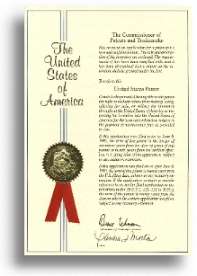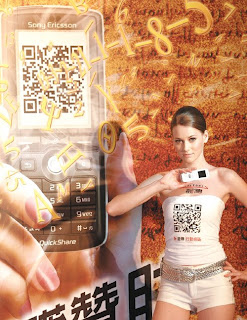In my opinion, DuPont is in the process of creating the 21st Century Barcode.
Physical world connection happens when a mobile device is able to scan a barcode (physical world hyperlink), resolve the barcode, and connect to the Internet.
To understand why it has taken longer than expected for Physical World Connection (PWC) to get adopted you need to know the obstacles it faces.
There's a standard 1d code (barcode) you find on consumer goods can be read by any retailer. A can of soup, DVD, book, allergy medicine, power tool etc all have a universal code that can be recognized by all scanners in supermarkets, Circuit City, CVS, Home Depot etc. For now, camera phones can't scan these 1D codes without a special lens attachment.
Most camera phones can scan 2d codes but where do you find them (Europe and States)? There are a dozen 2D code creating sites, but what is needed for mass adoption is a mass producer of 2d codes for/on consumer goods.
Probably the
biggest catalyst for Physical World Connection adoption occurred last week when DuPont licensed Scanbuy's interactive 2D barcode technology for packaging applications.
Because Dupont is probably the largest consumer good packaging company in the world, they can create the 2d code "standard" on consumer good packaging for mobile devices going forward. Once could say this is a "tip of the old Hatlo Hat" to Scanbuy when they explained to DuPont how they could be in charge of the domain registry for physical world connection for consumer goods.
Every consumer good can now have a physical world hyperlink (2D code) that can be scanned with numerous camera phones.
Being at the top of the "food chain", you can create the standard just on size alone.
When Scanbuy teamed up with Dupont in a licensing deal,they didn't just get one major brandthey got an international company that creates the packaging for thousands of major brands. Scanbuy has the ability to indirectly represent and connect thousands of major brands in several countries.
For an example. The 2d codes placed on a softdrink bottle DuPont produces aren't just for Coke, they can go on every soft drink bottle that is used by every soft drink brand.
Landing the largest consumer packaging good company will force the others (phone manuf, wireless carriers) to adapt/implement their business plans around this standard. See how powerful this licensing deal is now?
With Dupont stepping up to the plate, they will eliminate a lot of the indecision phone manuf, wireless carriers, BRANDS and mobile marketing companies are having.
Nokia already
adopted this code scanning application. I expect to see a major carrier adopt this application shortly.
In my opinion, this one development makes the Mobile Codes Consortium unnecessary. Their (MCC) mission for the mobile industry is to "create a consortium for a new mobile marketing ecosystem based around camera phones and 2D barcodes. A market-driven, open-standards approach will allow 2D barcodes to act as a catalyst in mobile internet adoption, mirroring the growth of web adoption over the last ten years".
DuPont is already doing this by adding this new "barcode" on their packaging.
Wouldn't it make sense for newspapers, magazines and other forms of media to adopt the same 2d code? Wouldn't it be easier for Coke to use the same 2d code on all forms of advertising?
I still think there will be a market for applications with proprietary 2d codes. I can think of some great ideas for this, but they shouldn't impede mass adoption of PWC.
I explained my thinking about the Mobile Codes Consortium in a post called
Mobile Codes Consortium A Consortium or a Conundrum? Conundrum resolved. Implementation supercedes discussion.
I agree that a 2d code standard should be set that will allow quicker adoption, but I think it would make more sense to invite a handset manufacturer, a wireless provider and a major brand into this consortium. After all, aren't those the players the PWC companies are trying to land? At least invite a PWC that has landed a handset company or wireless carrier.
Or maybe there's a reason they aren't.





 From Marketing Vox
From Marketing Vox 










 The reference rates are based on the regular daily concertation procedure between central banks within and outside the European System of Central Banks, which normally takes place at 2.15 p.m. ECB time (CET).
The reference rates are based on the regular daily concertation procedure between central banks within and outside the European System of Central Banks, which normally takes place at 2.15 p.m. ECB time (CET).


